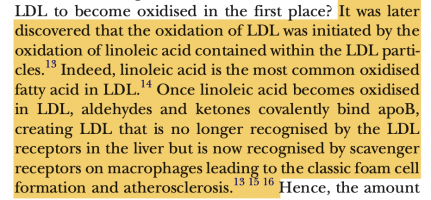Ell
Member
- Joined
- Nov 19, 2017
- Messages
- 152
Regulating my own intake o food, oils, including particularly the oils in my diet containing polyunsaturated chains, has been a big challenge. Compared to other matters relating to minerals, vitamins, & cet., managing the oils has been the most difficult. I meant this from the standpoint of incorporating a methodology it into my very being. It is not like, say, taking a selenium pill. I mean, with Se, or iodine, vitamin C, etc.... one just takes a pill of something, to remedy the deficiency. Not so easy with the oils. I read Dr. Peat's materials long ago, and at that time he was one of the early ones pointing out that excesses of the "wrong" fats seemed to be in commonplace, along with some others like Dr. Enig. As I see it now, a main issue is rancid oils. Whether a person knows it or not, most of the common foods contain rancid oils. It is the rancid PUFA's that are the problem, and it is because air-oxidation/polymerization creates different moleculear structures of oxidation products, than does the natural, normal enymatically controlled oxidation of PUFA's in a bio system, like my body. Rancid oils cause all sorts of trouble including even the big C. PUFA's are soooo important to immunity, but when a person habitully ingests excessive amts of "wrong" oils, like the restaurant eaters are huge violators, then it is like a vitamin B1 deficiency insomuch as it can manifest in several different ways. This puts the MD's at a disadvantage to get to the root of many patients' presentations. Imagine a person deficient in B1 and who is also eating crapola lipids !! No MD anywhere can ever help them, out of practicality in practice, unless they're looking for it ! How can a person shift their lipids intake from a shittty one to a better one ? Slowly. Incrementally. It is the same opposite way that Hemingway quipped on "How does a person go broke?" The answer is... you do it slowly for a while, then it happens all of a sudden. I like to think, I have my oils down pretty durn good. Thanks to The Almighty, every day, for leading me on this wonderful journey. Dietary Oils Management takes as much discipine, as it does knowledge.






